|
1.
CENTRAL AND WEST AFRICA
Generally dull international demand
The overall producer sentiment is that markets are dull
some experiencing low levels of activity. The Middle East
market in particular is currently characterised by low
demand which is linked to higher than usual stocks in Iraqi
and Dubai ports. In addition, shippers in West Africa face
competitive pricing from Indonesia and Malaysia in the
South African market.
Inquiries for some timber species such as okoume,
andoung, iroko, and padouk have fallen in the Asian and
Middle East countries. In Holland the high level of sawn
azobe stocks has impacted the flow of orders and led to a
slight decrease in demand for logs.
The market outlook is not very bright and hopes are
pinned on a rebound in demand in China after the Chinese
New Year. Demand in the Philippines is currently quiet.
Challenges in South Africa and changes in US import duty
advantages signal a dynamic period for producers.
Producers are of the understanding that the US
government has suspended Uganda, Gabon, Niger and the
Central African Republic (CAR) from its special US-
Africa trade programme set out in the African Growth and
Opportunity Act (Agoa) which provides eligible sub-
Saharan African countries with duty-free access to the US
for more than 1,800 products.
Regional challenges
Several African countries face challenges due to heavy
rainfall. In the Central African Republic transport
difficulties arise from heavy rain and this is impacting the
arrival of trucks at Douala Port. Producers in Cameroon
are also grappling with heavy rain which is causing delays
in log deliveries to mills. In Gabon, heavy up-country rain
and a recent train derailment have led to a 50% drop in log
supplies to mills in NKOK.
Peeling factories in the special economic zone (NKOK)
are under government pressure to reduce the number of
expatriate workers. The shortage of technicians for
peeling mills and mechanics for heavy machinery is
evident prompting companies to consider reducing
production. The government plans a comprehensive check
of the special zone managed by OLAM, including NKOK,
the port and the airport.
Revitalisation of associations in the Republic of Congo
With the support of ATIBT Congo through the Private
Sector Support Project financed by the European Union
the general meeting of the Union patronale des entreprises
privées de la filière bois (UNIBOIS) held in Pointe-Noire
ended with the appointment of the union's executive.
See:
https://www.atibt.org/en/news/13406/support-for-the-revitalisation-of-professional-associations-in-the-forestry-and-timber-sector-in-the-republic-of-congo
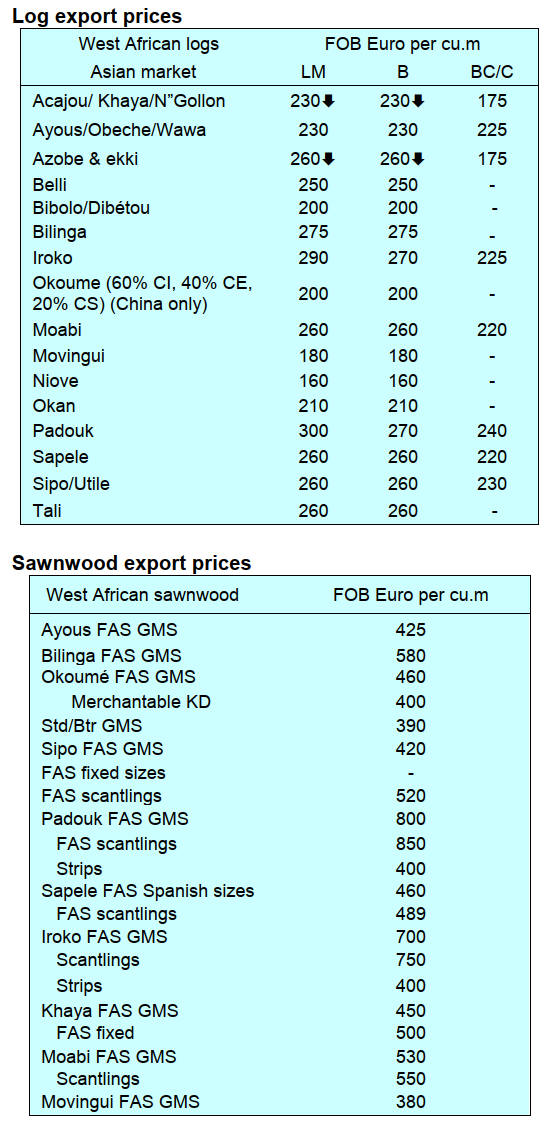
2.
GHANA
2024 budget – manufacturers disappointed
Ghana's Finance Minister, Ken Ofori-Atta, recently
presented the country's 2024 budget, signalling a positive
economic outlook with projections of accelerated growth
and declining inflation. The government expects the
economy to expand from a 2.3% growth rate in 2023 to at
least 2.8% in 2024.
The budget reflects Ghana's commitment to stabilise the
economy following a challenging period marked by high
inflation which peaked at 35% in October. With the
implementation of central bank policies inflation is
anticipated to fall to 15% by the end of 2024.
Ahead of the reading of the budget the Chief Executive
Officer (CEO) of the Association of Ghana Industries
(AGI), Seth Twum Akwaboah, stated that the
manufacturing sector faces numerous challenges which
stifles growth of local industries.
According to the AGI the tax system in Ghana is not
favourable for the manufacturing of goods for local
consumption or export. He expressed concern on the
numerous taxes that are not favouring manufacturing
mentioning a few such as the Growth and Sustainability
Levy and the Value Added Tax (VAT) which all add to
the cost of doing business.
The CEO also expressed concern about the country’s
porous borders which make it difficult for local
manufacturers to compete with imported products that get
into the country through unapproved routes and importers
escape taxes. In its 2024 pre-budget survey report KPMG
(Klynveld Peat Marwick Goerdeler) stated that businesses
in the country are urgently calling for a comprehensive
review of tax policies, improved power supply and a focus
on nurturing skilled labour.
After the budget was published the Chief Executive of the
Ghana Chamber of Commerce and Industry, Mark Badu-
Aboagye, expressed dissatisfaction as, according to him,
businesses and manufacturers were disappointed not to see
some tax relief and that this leaves them with little
optimism for the coming year.
See:
https://www.myjoyonline.com/current-tax-system-doesnt-favour-manufacturing-sector-agi/
and
https://mofep.gov.gh/sites/default/files/budget-statements/2024-Budget-Highlights.pdf
First eight months wood export slump
A total of 68,785cu.m. of wood products were exported in
the third quarter of 2023 compared to 81,683cu.m during
the second quarter a decline of around 16% in volume.
According to data from the Timber Industry Development
Division (TIDD) of the Forestry Commission total wood
export for the first nine months of 2023 dropped by 15%
to 227,245cu.m from the 267,622cu.m recorded in the
same period in 2022.
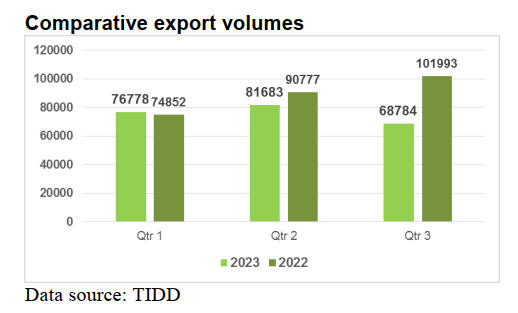
While in 2022 the volume of wood product exports
gradually increased that was not the case in 2023.
Exports in third quarter of 2023, 68,784 cu.m, earning
Eur30.64 million were below that in the same period in
2022 (101,993 cu.m and Eur45.56 million) representing
declines of 33% in volume and 33% in value. Products
that recorded significant volumes during the current year
included lumbers, veneers, plywood and billets.
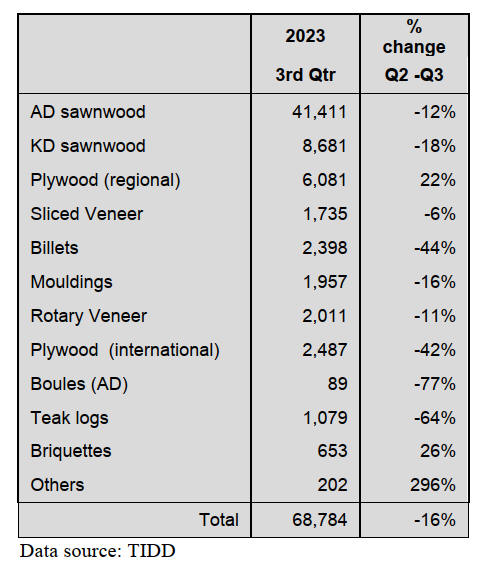
Of the wood products only plywood exported to the
regional West African markets and Briquettes to the
United Kingdom and Ireland recorded volume increases of
22% and 26% respectively in Q3 in 2023 compared to Q2
of the same year. Other wood products exported during the
period were dowels, sliced veneer to regional markets
kindling, KD boules and offcuts.
Ghana targets 24m tonnes of carbon credits by 2030
The Deputy Minister of Finance, Dr. John Kumah, has
hinted that Ghana is targeting 24 million tonnes of carbon
credits by the year 2030 as part of the country’s
commitment to reducing carbon emissions and mitigating
the impact of climate change.
Dr. Kumah made this known when members of the
Intergovernmental Committee of Senior Officials and
Experts for North and West Africa met in Accra on the
theme ‘Investing in Energy Transition, Food Security and
Regional Value Chains for Sustainable Development in
North and West Africa Sub-Regions’.
Ghana is among 15 other countries that have signed the
Emissions Reductions Payments Agreements (ERPA) with
the World Bank and could earn millions of dollars under
this project if successfully implemented.
See:
https://www.ghanaweb.com/GhanaHomePage/business/Government-targeting-24m-tonnes-of-carbon-credits-by-2030-John-Kumah-1875674
In a related development, the Ghana Forestry Commission
is, for the first in its history, supporting farmers in the
Northern Region of Ghana with the first 1,000 grafted
shea seedlings, to be planted on Ghana Shea Landscape
Emissions Reduction Project (GSLERP) sites. This falls
under the Reducing Emissions from Deforestation and
Degradation programme (REDD+), which has the
GSLERP, as one of its pillars.
See: https://fcghana.org/?p=4185

3. MALAYSIA
Wood product exports decline
The value of Malaysia’s exports of wood products
dropped 19% year-on-year to RM14 bil. between January
and August this year compared to RM17.3 bil. in the same
period last year. The Malaysian Timber Industry Board
(MTIB) chairman said this was not a surprise as there has
been a weakening in global demand.
Despite the slow sales this year he said he is confident that
the timber industry can reach the export target of RM28
bil. and domestic sales of RM20 bil. by 2025 in line with
the National Agri-commodity Policy 2021-2030 supported
by the National Timber Industry Strategic Plan 2021-2025.
According to him, the domestic market accounts for as
much as 60% of the country’s timber sector’s sales adding
that this year Malaysia ranks 14th globally among wooden
furniture-producing countries.
See:
https://www.thestar.com.my/business/business-news/2023/11/06/malaysias-wood-export-value-declines-191-in-january-to-august-2023
Interest rates unchanged
In an effort to remain supportive of the economy Bank
Negara has decided to keep its overnight policy rate (OPR)
unchanged at 3%. The move was in tandem with the US
Federal Reserve’s maintenance of its funds target rate at
5.25% to 5.5%. A Bank Negara spokesperson commented
that the current OPR level is conducive in holding up the
economy, consistent with the current assessment of
inflation and growth prospects.
Over the last few weeks there have been calls for the Bank
to consider raising the OPR to support the ringgit, which
remains one of the 10 worst-performing Asian currencies
this year. However, economists have warned this would
only lead to higher household and business costs, hence
dampening domestic demand.
Aiming for a sustainable bamboo supply
Sarawak Timber Industry Development Corporation
(STIDC), the Bintulu Development Authority (BDA) and
Pertama Ferroalloys have signed a Memorandum of
Understanding on a Samalaju greening project and the
supply of sustainable raw materials through bamboo
cultivation.
STIDC and BDA will supply quality bamboo seedlings to
the project, communities and commercial entities, offer
technical expertise, oversee bamboo planting and
management and identify potential bamboo consumers.
See:
https://dayakdaily.com/stidc-bda-and-pertama-ferroalloys-sign-mou-on-samalaju-greening-project-sustainable-supply-of-bamboo/
Oil palm sector could benefit from embracing
agroforestry
Oil palms are planted in monoculture plantations but
monocultures have been criticised. One specialist
recommended that oil palm plantation companies should
adopt agroforestry as this approach will increase
biodiversity and sustainability.
Professor Alain Rival from the French Agricultural
Research Centre for International Development (Cirad)
said agroforestry is the use of land that combines trees
with crops or livestock or both. He said that through this
approach oil palm plantation owners could select any
forest tree species to be planted in between oil palms.
As an example, Rival cited Cirad’s trial projects where the
agroforestry approach was applied on 37 hectares of land
in the Kinabatangan District in Sabah to combine oil palm
with 15 different forest species.
Rival said that land owners could grow durians,
mangosteen, pepper and vanilla, among others, as cash
crops. He said smallholders, especially, can benefit from
these cash crops.
See:
http://theborneopost.pressreader.com/article/282192245702320
Heart of Borneo framework to be reviewed
Sarawak is revising the framework for the Heart of Borneo
(HoB) initiative to ensure that it would align with the
state’s existing policies and development
agenda, particularly the Post COVID-19 Development
Strategy 2030 (PCDS 2030). The state’s Forest
Department, as the secretariat for HoB Sarawak, is
currently working on the final draft of the revised project
implementation framework.
This document will guide the prioritisation and
implementation of programmes and activities within the
Heart of Borneo region up to the year 2030. It is not
intended to replace the earlier 2009 framework but rather
serves as an updated and supplementary document to it.
See:
https://sarawaktok.bernama.com/news.php?c=02&id=2234213
Workplace furniture, a focus for MIFF 2024
The Malaysian International Furniture Fair 2024 will take
place 1 – 4 March 2024 in Kuala Lumpur. One aspect of
the Fair is to promote diverse office furniture. Office
furniture design is undergoing a transformation driven by
the changing needs and priorities of businesses. As
companies continue to create a more comfortable, inviting
and productive working environment this reshaping office
interior designs.
See:
https://www.miff.com.my/media/news-and-featured-articles/146/the-evolution-of-modern-workplaces/
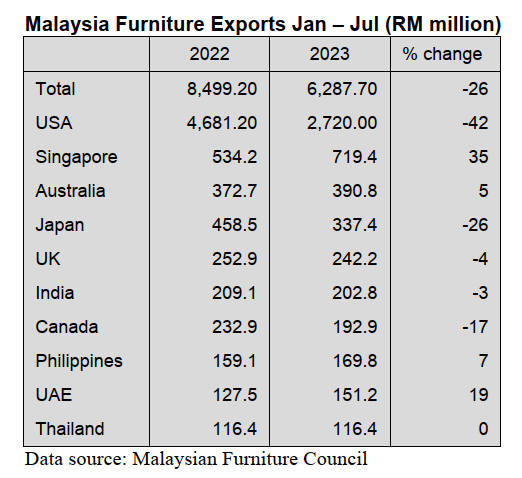
4.
INDONESIA
Export benchmark prices
for November
The November Export Benchmark Price (HPE) for wood
products has been released by the Ministry of Trade. The
HPE increased for several products.
Prices increased for veneer from natural forest species and
plantation wood, wooden sheets for packing boxes and
woodchip/particles. The increase in HPE also applies to
sawnwood with a cross-sectional area of 1,000–4,000
sq.mm in meranti, merbau, teak, acacia and balsa.
For some products the price was lowered, namely sawn
sengon with a cross-sectional area of 1,000 sq.mm–4,000
sq.mm.
The following is a list of Wood HPE for November 2023.
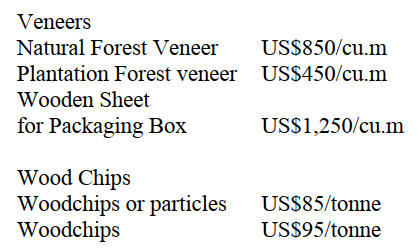
Processed Wood
Processed wood products which are level on all four sides
so that the surface becomes even and smooth with the
provisions of a cross-sectional area of 1000 sq.mm to 4000
sq.mm(ex 4407.11.00 to ex 4407.99.90)
 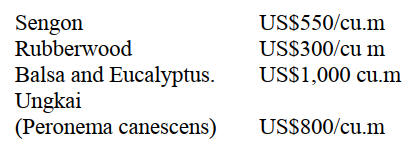
Processed wood products which are leveled on all four
sides so that the surface becomes even and smooth with
the provisions of a cross-sectional area of 4000 sq.mm to
10000 sq.mm(ex 4407.11.00 to ex 4407.99.90)

See:
https://forestinsights.id/harga-patokan-ekspor-hpe-kayu-november-2023-ada-kenaikan-untuk-kayu-gergajian-meranti-merbau/
Independent audits key to SVLK transparency
A transparent and accountable audit process by
Conformity Assessment Bodies (CAB) is one of the
advantages of the Indonesian Legality and Sustainability
Verification System (SVLK) in support of forest
governance said Karina Restu Panggalih, Sustainable
Forest Management Auditor at PT Mutuagung Lestari, one
of the CABs She added that based on the regulations from
the Ministry of Environment and Forestry an institution
can become a CAB after receiving accreditation from the
National Accreditation Committee (KAN).
“Accreditation is based on the international standard
ISO17065 in 2012 regarding the criteria for financial
institutions implementing product, process and service
certification systems,” said Karina during a discussion
between the CAB Forum and a delegation of forestry
experts from Laos.
Karina explained that the SVLK audit refers to the
regulations set by the Ministry. Such as Regulation No.
P.08/2021 concerning Forest Management and Preparation
of Forest Management Plans and Decree No. 9895/2022
concerning Standards and Guidelines for Implementing
the Legality and Sustainability Verification System
(SVLK). “SVLK is implemented through two activities,
assessment for sustainable forest management and legality
verification for forest products,” said Karina.
See:
https://forestinsights.id/independent-auditors-and-monitors-key-to-svlk-transparency-and-accountability/
and
https://agroindonesia.co.id/auditor-dan-pemantau-independen-kunci-transparansi-dan-akuntabilitas-svlk/
Indonesia shares experience in developing SVLK with
Laos
The Ministry of Environment and Forestry (KLHK)
recently shared its experience in developing the Legality
and Sustainability Verification System (SVLK) with a
delegation from Laos.
Agus Justianto, Director General of Sustainable Forest
Management told the delegation from Laos that the SVLK
has been key in encouraging better governance in the
forestry sector taking into account requirements in
international markets.
The latest SVLK developments include improving
traceability with geo-location. In addition some indicators
have been strengthened such as welfare and gender issues.
The Director General of the Forest Inspection Department
of the Laotian Ministry of Agriculture and Forestry,
Khamphone Mounlamai, said that Laos has also developed
a timber legality assurance system and hopes to reach a
FLEGT-VPA agreement in the near future.
The Laotian delegation comprised officials from the
Ministry of Agriculture and Forestry, Ministry of Trade,
provincial government, civil society organizations (CSOs)
and business representatives. The delegation's visit to
Indonesia was supported by the German Agency for
International Cooperation (GIZ), the German
Development Bank (KfW) and the European Forest
Institute (EFI).
The Loa delegation visited Malang and Surabaya in East
Java Province to observe how the Indonesian SVLK is
implemented. One aspect that attracted the attention of the
Lao delegation was the use of Supplier’s Declaration of
Conformity (SDOC) so low risk planted timber produced
by farmers or other micro-scale forestry business units
could be included in Indonesia’s SVLK and have full
market access.
See:
https://en.antaranews.com/news/297015/indonesia-shares-experience-on-developing-svlk-with-laos
and
https://agroindonesia.co.id/kunjungi-jawa-timur-delegasi-laos-pelajari-implementasi-svlk-indonesia/
Industry ready to intensify presence in Asian markets
Wiradadi Soeprayogo, Chairman of the Indonesian
Sawmill and Woodworking Association (ISWA), said the
timber industries are ready to intensify marketing in Asian
countries as they anticipate a further decline in demand in
Europe and America which is already having a negative
impact on ISWA members business.
He said in 2022 the export value of wood products and
sawnwood reached US$2.4 billion but in 2023 (as of
November) a decline of 13% was observed. He added that
to penetrate new markets exporters must be prepared to
meet the specific requirements in the various markets and
prepared to address their concerns on environmental
issues.
He said that these various challenges cannot be overcome
by ISWA alone but require inclusive collaboration with
related parties, namely the government, universities and
professional organisations.
See:
https://www.antaranews.com/berita/3794706/industri-kayu-gergajian-dan-olahan-siap-intensifkan-pasar-asia
Carbon trading still a challenge
Chairman of the Indonesian Forest Concessionaires
Association (APHI), Indroyono Soesilo, explained that
Carbon Economic Value (NEK) is one source of funding
to achieve Indonesia’s GHG emission reduction target. To
implement carbon economic value the Indonesian
government has issued a number of regulations.
“However, implementation is still full of challenges,” he
said when speaking an International Webinar “Lesson
Learned on the Utilisation of the Carbon Economic Value
on Mitigation Action in Forest Management.
APHI Secretary General, Purwadi Soeprihanto, explained
that one of the challenges faced by forest concession
companies (PBPH) in implementing carbon economic
value is the methodology for measuring GHG emission
reduction performance. This is because the methodology
applied still does not fully cover the 2030 FOLU Net Sink
mitigation action.
He said “It is necessary to accelerate the ratification of the
methodology that can be applied to PBPH in accordance
with the 2023 FOLU Net Sink mitigation action,”
See:
https://lestari.kompas.com/read/2023/11/08/200000686/pengusaha-hutan-sebut-perdagangan-karbon-indonesia-hadapi-tantangan-?page=all
In related news, the Ministry of Environment and Forestry
(KLHK) has introduced the concept of carbon trading in
the forestry sector to improve the economy in Southwest
Papua Province. The Secretary of the Directorate General
of Sustainable Forest Management (PHL) of the KLHK,
Drasospolino, explained the benefits through carbon
trading in the forestry sector.
The approach of the KLHK through socialisation is
considered important so stakeholders and businesses can
understand the procedures, requirements and calculations
when viewing carbon trading results. He said that, in
general, there are two mechanisms for carbon trading in
the forestry sector: emissions trading and greenhouse gas
emissions offset. Because of this, he said, the Southwest
Papua Province has a great opportunity to contribute to
efforts to reduce greenhouse gas emissions through direct
and offset emission reductions.
See:
https://en.antaranews.com/news/297960/klhk-introduces-benefits-of-carbon-for-economic-improvement-in-papua
Converting palm plantations back to forest
Some 200,000 hectares of oil palm plantations found in
areas designated as forests in Indonesia are expected to be
returned to the state to be converted back into forests.
Indonesia, the world's biggest palm oil producer and
exporter, issued rules in 2020 to determine the legality of
plantations operating in areas that are supposed to be
forests in order to adjust governance in the sector.
It has been estimated that 3.3 million hectares of the
country's nearly 17 million hectares of palm plantation are
found in areas classified as forest.
The government is still cataloguing plantations found in
designated production forests so these areas can be
returned to the State for rehabiliation, meaning owners
will have to pay fines but they can continue to grow palm
trees and which are in protected areas and must be
returned to the state, he said.
See:
https://english.kontan.co.id/news/indonesia-says-200000-hectares-of-palm-plantations-to-be-made-forests
21% of the world's mangrove forests are in Indonesia
The Ministry of Environment and Forestry (KLHK) said
that Indonesia has 3.39 million hectares of mangroves or
21% of the total mangrove forests in the world.
Director of Land Water and Mangrove Rehabilitation at
the Ministry of Environment and Forestry, Inge Retnowati,
said that based on the 2022 National Mangrove Map the
area of mangroves in Indonesia increased to 3.39 million
hectares up from the 3.36 millin ha. is 2021.
The province with the largest mangrove forest is Papua
which has more than 1 million ha. followed by West
Papua Province with 480,000 ha. and Riau with 227,000.
See:
https://katadata.co.id/tiakomalasari/ekonomi-hijau/6538708fc6c13/21-hutan-mangrove-dunia-ada-di-indonesia-ini-3-provinsi-terbesar
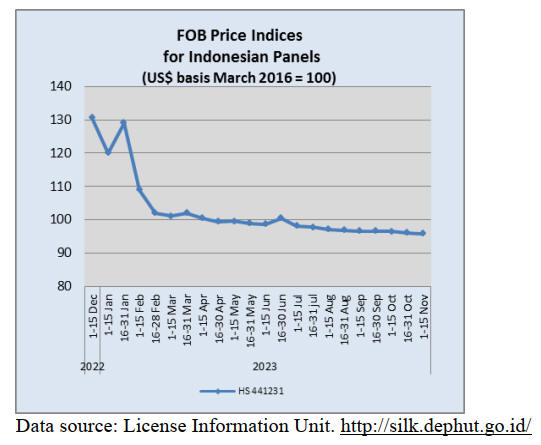
5.
MYANMAR
Myanmar furniture makers eye the domestic market
The Myanmar Wood-Based Furniture Association
(MWBFA) sponsored the Myanmar Furniture Exhibition
2023 at a popular shopping mall to promote sales in the
domestic market in the face of falling international
demand and trade restrictions. This event was timed to be
during the so-called ‘marriage season’ when demand for
furniture rises.
Furniture manufacturers face a major challenge from
imported furniture which is often cheaper than locally
made items.
In addition to the classic designs with solid wood,
manufacturers have started to use the finger-jointed
plantation teak.
Myanmar teak was in demand in international markets for
garden furniture but this market has closed due to
international measures against Myanmar wood products
and the strict domestic regulation of export procedures for
wood products some of which have been eased recently.
Reducing the dependency on US dollar
The Industrial and Commercial Bank of China (ICBC)
Yangon Branch joined China’s Cross-Border Interbank
Payment System (CIPS). The Central Bank of Myanmar
(CBM) Governor, Than Than Swe, said membership will
enable Myanmar to greatly reduce its dependence on US
dollars for international transactions.
Myanmar Prime Minister, General Min Aung Hlaing, has
often commented that some countries are using US dollars
“to bully smaller nations.” He has since been seeking ways
to replace the use of the dollar and promoting the use of
the Chinese yuan (RMB) and Russian ruble.
ICBC Yangon Branch is among the first commercial
banks that have been authorised to provide RMB financial
services for border trade between China and Myanmar.
These services include RMB account opening, deposits,
settlements, financing and foreign exchange for both
Chinese and Myanmar clients.
Than Than Swe said the CIPS system offered an
alternative to the Society for Worldwide Interbank
Financial Telecommunication (SWIFT). The authorities in
Myanmar have been encouraging exporters and importers
to use yuan, baht and rupees in the border trade with
China, Thailand and India.
See:
https://www.irrawaddy.com/business/myanmar-branch-of-icbc-joins-chinas-global-trade-payment-system.html
Border trade disrupted
It has been reported that Myanmar traders are suffering
huge losses after fighting in Shan State has almost shut
down the country’s main China border trade. It is reported
that the ethnic Brotherhood Alliance has taken control of
all major routes to the border trading towns of Muse, Chin
Shwe Haw, Laukkai and Hseni since launching an
offensive in October.
The Muse border zone accounts for about 70% percent of
Myanmar’s cross-border trade with China. Exporters
handling perishable goods are also facing huge losses. In
addition the authorities in Myanmar are losing an
estimated US$400,00 per day in tax revenue from lost
border trade.
See:
https://www.irrawaddy.com/business/myanmar-china-trade-corridor-closed-as-battle-rages-in-northern-shan.html
US Treasury prohibits financial services by US
entities
with Myanmar energy company
The U.S. Department of the Treasury’s Office of Foreign
Assets Control (OFAC) published a new directive that
prohibits certain financial services by U.S. persons to or
for the benefit of Myanma Oil and Gas Enterprise
(MOGE).
The Directive says:
“Pursuant to sections 1(a)(iv), 1(b), and 8 of Executive
Order 14014, “Blocking Property With Respect to the
Situation in Burma” (the “Order”), the Director of the
Office of Foreign Assets Control (OFAC) has determined,
in consultation with the Department of State that the
Myanma Oil and Gas Enterprise (MOGE) is a political
subdivision, agency, or instrumentality of the Government
of Burma, and that the following activities by a U.S.
person are prohibited on or after December 15, 2023
except to the extent provided by law or unless licensed or
otherwise authorised by OFAC: the provision, exportation
or re-exportation, directly or indirectly, of financial
services to or for the benefit of MOGE or its property or
interests in property.
All other activities with MOGE or involving MOGE’s
property or interests in property are permitted, provided
such activities are not otherwise prohibited by law, the
Order, or any other sanctions program implemented by
OFAC. Except to the extent otherwise provided by law or
unless licensed or otherwise authorized by OFAC, the
following are also prohibited: (a) any transaction that
evades or avoids, has the purpose of evading or avoiding,
causes a violation of, or attempts to violate any of the
prohibitions contained in this Directive; and (b) any
conspiracy formed to violate any of the prohibitions in this
Directive.”
Additionally, OFAC designated three entities and five
individuals connected to Burma’s military regime pursuant
to Executive Order (E.O.) 14014. These actions are
occurring in alignment with designations by both the
United Kingdom and Canada.
See:
https://ofac.treasury.gov/recent-actions/20231031
and
https://www.upstreamonline.com/energy-security/-a-basic-necessity-pttep-ploughs-on-with-myanmar-gas-production-after-us-sanctions-partner/2-1-1549748
6.
INDIA
Economy recovered but
growth slowed recently
During the COVID pandemic India’s Gross Domestic
Product (GDP) growth slowed to 6.6% but the economy
has made a rapid recovery in the two consecutive years
following COVID as the economy has grown at rates of
9.1% and 7.2%. However, in recent months, there has
been a slight slowdown. Despite weaker results reported
by Indian IT companies the services sector has remained
strong and exports are robust.
The strengthening of the digital infrastructure in
India has
led to increased accessibility to affordable transactions
across the entire country and the government’s expanded
direct benefit transfer programmes have become easily
accessible to the people.
In addition, increased capital expenditure has significantly
improved the physical infrastructure especially in the
transportation sector.
The Reserve Bank of India (RBI) has been working to
keep the Consumer Price Index (CPI) below 6%. Over the
past few years there has been significant improvement in
company balance sheets and this has encouraged lending.
Peeler logs now more readily available
PlyReporter, the Indian trade journal, writes there are
signs of an easing of log supplies to plywood makers in
the northern States of Yamunanagar, Ludhiana,
Hoshiarpur and Rudrapur as poplar logs are more readily
available but that these are mostly of small girth.
Since 2017 every state in the Northern Region has been
actively planting poplar and now the extent of poplar
plantations exceeds that of eucalyptus in Punjab and
Haryana. A boost to the sector in Haryana came when the
Chief Minister of the State halved the market fee from 2%
to 1%. He is reported by PlyReporter as saying “this will
help the Yamunanagar plywood industry and
Yamunanagar district (Northern India) based units as they
will save approximately Rs.60 million annually and this
will be a big support for industries.“
The supply of plywood to the market has been supported
by increasing imports of core veneer from Vietnam,
Tanzania, Brazil and logs for core veneer peeling from
Uruguay, Australia and Argentina.
The plywood industries based in Gujarat, West Bengal,
Maharashtra, Andhra Pradesh were buying core veneer
from Northern India but, due to high price of domestic raw
material, many shifted to imported core veneers and logs.
The shift to imported core veneer is helping North India
based plywood manufacturers as domestic raw material is
more readily available.
See:
https://www.plyreporter.com/article/93397/north-to-get-relief-by-2nd-half-of-2023-timber-supply-to-ease-up-for-punjab-haryana-ply-reporter-prediction-2023
Tamil Nadu potential as furniture hub
Government and industry sources are upbeat about
prospects for the furniture manufacturing sector in Tamil
Nadu given its skilled manpower and access to ports. It is
hoped that Tamil Nadu can transform into a hub for
furniture production and exports as companies pursue the
‘China plus policy’ and explore alternatives to the Chinese
market. The potential for exports is huge since India has
only 5% share of the world market.
Moreover, the India/Australia Economic Cooperation and
Trade Agreement (ECTA) and India/UAE Comprehensive
Economic Partnership Agreement (CEPA) signed last year
offer zero-duty market access for made-in-India furniture
to these markets. In addition to expanding into new
international markets there are opportunities in the
domestic market. The value of the Indian furniture market
thought to be around US$32 billion with an annual growth
of 20%-25%.
See:
http://timesofindia.indiatimes.com/articleshow/104999876.cms?utm_source=contentofinterest&utm_medium=text&utm_campaign=cppst
Press release from organisers of WOFX
WOFX, World Furniture Expo 2023 will be held 28-30
November 2023 at the Bombay Exhibition Center,
Mumbai. This event is dicated to business to busness
interactions for the furniture sector in India. As a
dedicated furniture and interior décor show WOFX aims
to connect leading builders, architects, dealers,
distributors, importers, retailers, etailers and other buyer
groups .
The event will bring to India the latest designs,
innovations and technological developments in the
furniture industry by showcasing suppliers from India,
Bangladesh, Singapore, Thailand, Malaysia, Indonesia,
Vietnam, China, Turkey and more.
See:
https://wofxworldexpo.com/press-release-4
The import data has not been updated for November as
Diwali celebrations made it difficult to gather the
information. The October information is reproduced
below.
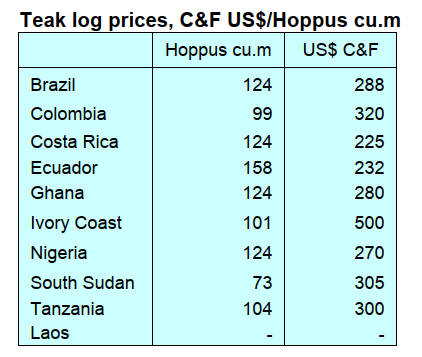  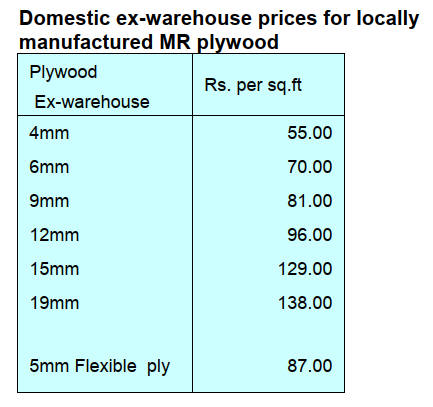
7.
VIETNAM
Wood and Wood Product (W&WP) trade highlights
Vietnam’s W&WP exports in October were around
US$1.2 billion, up 5.7% compared to September 2023 but
down 0.9% compared to October 2022. In particular, WP
exports are forecast to have earned US$790 million, up
4% compared to September 2023 and up 0.3% compared
to October 2022. WP exports alone should be valued at
US$7.3 billion, down 22% over the same period in 2022.
Vietnam's W&WP imports in October 2023 are estimated
at US$180.0 million, down 5% compared to September
2023 and down 19% over the same period in 2022. Up to
the end of October 2023 W&WP imports were valued at
US$1.786 billion, down 31% over the same period in
2022.
Vietnam's imports of raw wood (logs and sawnwood) in
October 2023 are estimated at 424,500 cu.m, worth
US$135.0 million, up 8% in volume and 8% in value
compared to September 2023. However, as compared to
October 2022 it decreased by 14% in volume and 24% in
value.
In the first 10 months of 2023 imports of raw wood
reached 3,704 million cu.m, worth US$1,262 billion, down
27% in volume and 35% in value over the same period in
2022.
Vietnam’s exports of non-timber forest products (NTFPs)
in October 2023 are estimated at US$60 million, up 14%
compared to September 2023 bringing total NTFP exports
in the first 10 months of 2023 to US$598.69 million, down
14% over the same period in 2022.
W&WP exports gradually recovering
WP exports alone contributed US$7.3 billion, down 22%
over the same period in 2022. However, in October, with a
monthly earning of US$1.2 billion, W&WP export values
have increased by 6% compared to September 2023 and
shown a certain level of recovery.
Despite recovery signals, the wood processing industries
still face many difficulties and the growth of the sector is
still hindered by the gloomy global economy and
weakened W&WP demand. As a result, Vietnam’s export
target of US$17 billion in 2023 cannot be achieved.
It is expected that in the last 3 months of 2023
W&WP
exports will add about US$4 billion bringing exports in
2023 to between US$13.6 – US$14 billion.
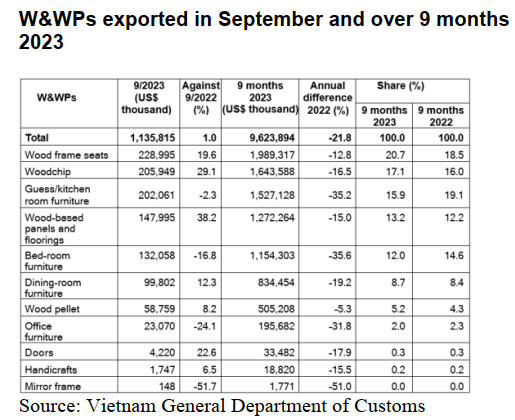
Export markets
W&WP exports to the top market, the US, showed signs
of recovery in September 2023 with the growth rate of
7.5% compared to September 2022, narrowing the decline
in the first 9 months of this year. W&WP exports to the
US over the first 9 months of 2023 were valued US$5.2
down 24% year on year.
The recovery of exports to the US is an optimistic signal
for the industry as the US often consumes 50 - 55% of
total W&WPs exports from Vietnam. In the last 3 months
of 2023, W&WP exports to the US are expected to recover
thanks to a better US economic outlook as well as the
reduction of inventories and inflationary pressures.
In addition to the US market, W&WP exports to other
markets in the first 9 months of 2023 all declined. In
particular, exports to Japan reached US$1.3 billion, down
9%; China US$1.2 billion, down 25%; South Korea
US$583 million, down 21%; EU US$303.5 million, down
37%.
Forecast
Vietnam's W&WP exports in the first 10 months of this
year are estimated at US$10.8 billion, down 20% over the
same period in 2022. The main reason behind this
downturn is the lack of orders from major markets. This
trend has been prevailing since the end of 2022 and lasting
through the first months of 2023.
However, demand for furniture in international markets
and Vietnam's supply capacity are both positive. From
August 2023, buyers have started to return.
The recently signed free trade agreements are
expected to
facilitate made-in-Vietnam furniture shipments to potential
markets such as the EU, Asian countries and the Middle
East.
The outlook for W&WP exports is expected to be more
positive in the last months of 2023 with the
revitalisation of property markets and increasing
demand for home furniture replacement before the New
Year holidays.
W&WP imports in the first 10 months of 2023
According to preliminary statistics, Vietnam's log and
sawnwood imports in October 2023 amounted to 424,500
cu.m, worth US$135.0 million, up 8% in volume and 8%
in value compared to September 2023. However,
compared to October 2022, it decreased by 14.0% in
volume and 24.4% in value.
In the first 10 months of 2023, log and sawnwood
imports
totalled 3.704 million cu.m, worth US$1,262 billion, down
279% in volume and 35% in value over the same period in
2022.
Suppliers
In the first 9 months of 2023 import volumes of raw wood
from major markets such as the EU, USA, China,
Cambodia, Chile and Laos dropped against the same
period in 2022, while the imports from smaller suppliers
such as Thailand, Malaysia, Indonesia and Sierra Leone
increased slightly.
Log and sawnwood imported from the EU accounted for
18% of total imports, reaching 575,800 cu.m, worth
US$174.7 million, down 11% in volume and 20% in value
over the same period in 2022.
Imports of raw wood from the US decreased by 26% in
volume and 34% in value over the same period in 2022
with the volume of 391,900 cu.m, worth US$167.3 million
a 12% share of total imports.
Imports of raw wood from Chinat decreased by 26% in
volume and 39% in value over the same period in 2022,
amounting to 388,000 cu.m, worth US$181.4 million and
accounted for 12% of total imports.
In addition, the import volume of raw wood from some
other suppliers decreased over the same period in 2022
such as; from Cameroon decreased 22%; Chile fell 10%;
Laos minus by 25%; Brazil dropped by 44%; New Zealand
down by 16%; Russia by 27%.
Imported species
Statistics from the General Department of Customs reveal
that in the first 9 months of 2023 the import volume of
major species such as pine, tali, poplar, oak, pachi/doussi,
padauk and eucalyptus dropped year-on-year while the
imports of other species increased (rubber, teak, fir,
pecans).
Pine, as the top imported wood, accounted for
15% of total
raw wood imports in the first nine months of 2023
reaching 508,000 cu.m, worth US$111.6 million, down
37% in volume and 50% in value over the same period in
2022.
Tali imports decreased by 25% in volume and 23% in
value over the same period in 2022, reaching 297,200
cu.m, valued at US$124.2 million, accounting for 9% of
the total imported raw wood.
Poplar imports decreased by 19% in volume and 33% in
value compared to the same period in 2022, reaching
235,100 cu.m, valued at US$97.6 million.
In addition, the import volume of some species
decreased
as compared to the same period in 2022 such as oak
decreased by 7.5%, pachi/doussi by 63%, padauk by 30%,
eucalyptus by 62%, mukulungu by 14%; sapele by 45%.
In contrast, imports of ash in the first 9 months of
2023
increased by 12% in volume and 10% in value over the
same period in 2022, reaching 404,200 cu.m, worth
US$103.8 million and accounted for 12% of total imported
raw wood.
In addition, import volumes of some woody species
increased over the same period in 2022 such as
rubberwood increased by 12%, teak by 50%, spruce by
110%, pecan by 46%, menghundor by 38%, mersawa by
9%.
Prices
In the first 9 months of 2023 the average price of raw
wood imported into Vietnam stood at US$343.8/cu.m,
down 11% over the same period in 2022.
In particular, the price of raw wood from the EU
decreased
by 10% to US$303.3/cu.m, from the US by 10%, to
US$426.8/cu.m, China down by 17%, to US$467.6/cu.m,
Laos dropped by 8%, to US$469.0/cu.m.
Non-timber forest product exports decreasing
According to the General Department of Customs, NTFP
exports in September 2023 amounted to US$52.83 million,
down 17.9% compared to August 2023 but up 6.5%
compared to September 2022. Over the first 9 months of
2023, Vietnam’s NTFP exports were valued at US$538.69
million, down 16% over the same period in 2022.
In October 2023 the US$60 million from NTFP exports is
expected to bring total exports in the first 10 months of
2023 to US$598.69 million, down 14% year-on-year.
Vietnam, a model in forest protection and sustainable
development
Vietnam intends to implement international commitments
and also create new values for agricultural development.
The European Commission (EC) has recognised
Vietnam’s quick action in adapting to the European Union
Deforestation-free Regulation (EUDR), saying Vietnam's
message of turning challenges into opportunities has
inspired the EC in working with partners.
The information was revealed at a working session
between a delegation from the Ministry of Agriculture and
Rural Development (MARD) led by Minister Le Minh
Hoan and the EC’s officials.
During working sessions with the EC Commissioner for
Environment, Oceans and Fisheries, Virginijus
Sinkevičius, Hoan stated that the Vietnamese
Government's policy is to guide agriculture towards an
ecological, green and sustainable direction.
Vietnam not only wants to implement international
commitments but to create new values for agricultural
development accompanied by environmental protection,
preserving resources for future generations, and
contributing to global sustainable development, he said.
The Minister also highlighted the Vietnamese
Government's commitment to developing a transparent,
responsible, and sustainable agricultural sector as Vietnam
has become a major food supplier in the world.
Regarding the EUDR, Hoan said that Vietnam's message
of compliance with the regulations meets the requirements
for exporting coffee, rubber, wood and wood products to
the EU market. It is also an opportunity to develop
Vietnam's agriculture sector in line with the sector's
strategic orientation of transparency, responsibility,
sustainability and green growth.
As soon as EC approved the EUDR, MARD participated
in many in-depth discussions at both EC’s technical and
leadership levels as well as quickly directed specialised
agencies to prepare an adaptation action plan framework
for the EUDR.
See:
https://en.vietnamplus.vn/vietnam-becomes-global-model-in-forest-protection-sustainable-development-ec/270014.vnp
8. BRAZIL
Forest biomass potential
as a source of energy
Law No. 233/2005 addresses forest policy and also deals
with forest replacement and after the introduction of
regulation No. 06/2022, forest residues (stumps, roots,
branches) that used to be burned began to be used for
bioenergy production.
A study by the Secretaria do Meio Ambiente e
Infraestrutura (SEMA) on the Coefficient of Volumetric
Yield (CRV) proved to be fundamental to making
sustainable forest management projects more viable
through the utilisation of stumps, roots and branches.
Demand for the forest biomass continues to grow in the
state of Mato Grosso.
According to a survey carried out by the Center of Timber
Producing and Exporting Industries of Mato Grosso State
(CIPEM) based on indicators gathered by the Federation
of Industries of Mato Grosso (FIEMT), the value produced
in 2022 from biomass exceeded all previous years.
Last year, R$310.1 million was earned from the annual
production of 3.5 million cubic metres, representing an
doubling of production.
CIPEM said, in view of the high demand for biomass
it is
essential that the environmental licensing agency
establishes procedures that are consistent with the reality
of enterprises that produce biomass for energy generationt.
See:
https://cipem.org.br/noticias/potencial-da-biomassa-florestal-como-fonte-de-energia
Illegal logging in non-designated public forests
Around 38,000 hectares of forest in Pará State in the
Amazon Region, were logged of which 46% (17,800
hectares) occurred illegally between August 2021 and July
2022, according to the Logging Monitoring System -
SIMEX (Sistema de Monitoramento da Exploração
Madeireira).
Much of this logging was in public forests that have not
yet been designated for a defined use by the State. In these
non-designated public land areas, 1,711 hectares were
illegally harvested representing an increase of 86%
compared to the previous period (August 2020 to July
2021) when 919 hectares of unauthorised logging was
identified.
SIMEX data shows that of the total illegally logged area of
13,300 hectares occurred within registered properties.
Illegal logging in non-designated areas accounted for 9.5%
of the total. Protected areas accounted for 5.8%, 5.3% in
indigenous lands and 0.5% in conservation units.
The municipalities with the largest areas of illegal activity
were: Paragominas, with 4,167 hectares (23%); Dom
Eliseu, with 2,741 hectares (15%); and Goianésia do Pará,
with 1,696 hectares (9%).
The monitoring system showed that there was a reduction
in logging in protected areas during the period analysed. In
indigenous lands, illegal logging fell to just 951 hectares.
In conservation units the area logged without authorisation
went from 126 hectares in the previous period to 96
hectares. The most affected protected areas in the latest
monitoring work were the Amanayé indigenous land, the
Jamanxim National Parkand the Sarauá indigenous land.
See:
https://www.remade.com.br/noticias/19546/extracao-ilegal-de-madeira-cresce-em-areas-ainda-nao-destinadas-do-para
Mato Grosso expands its timber exports
The state of Mato Grosso in the Amazon Region is Brazil's
fourth largest timber exporter and generated around
US$71 million in exports of forest products between
January and September 2023. Almost half of all
municipalities in the state have forest-based industries
with Colniza and Aripuanã leading the state's log
production according to the Brazilian Institute of
Geography and Statistics (IBGE).China and India stand
out as important consumers of wood products from Mato
Grosso harvested from areas with sustainable forest
management plans. According to the Ministry of
Agriculture and Livestock (MAPA), up to September
India imported 38,101 tonnes (US$20.5 million) and
China imported 8,964 tonnes (US$6.8 million).
It should be noted that Mato Grosso's wood product
exports to India are mainly teak from forest plantation and
the state hopes to expand exports of native timber species
from sustainable forest management.
Ahead of Mato Grosso, the largest exporting states up to
September 2023 were Santa Catarina (US$1 billion), Rio
Grande do Sul (R$436.7 million) and Pará (US$177.1
million).
In order to increase exports to China and India CIPEM
plan lead a delegation of entrepreneurs from the forest
sector to participate in the Global Wood Forum in Macau,
November 21-22.
See:
https://forestnews.com.br/mato-grosso-exportacoes-madeira-mercados-globais/
Export monitoring provides indicators of furniture
trade
The "Monitoring of Furniture Exports" report developed
by Market Intelligence (IEMI) was produced exclusively
for companies associated with the Brazilian Furniture
Sector Project, an initiative of ABIMÓVEL (Brazilian
Furniture Industry Association) and Apex Brasil (Brazilian
Trade and Investment Promotion Agency) with the aim of
boosting exports and the internationalisation of Brazil's
furniture industry.
The study tracks exports in four main product categories
(upholstered furniture, wooden furniture, metal furniture
and mattresses), observing the monthly variation in
exports of 17 key products which are representative for the
categories and markets of strategic interest. In September
2023 Brazil exported approximately US$57.9 million
(FOB) in furniture, representing a drop of 11% compared
to the same month in the previous year.
Furthermore, exports to different countries showed
significant variations. There was a sharp drop in exports to
Germany (61%), Colombia (51%), the United States
(28%) and Peru (22%). On the other hand a significant
increase in the monthly variation of exports was recorded
in the United Arab Emirates (158%), followed by Chile
(19%), Mexico (62%), Panama (74%) and the United
Kingdom (12%).
The ABIMÓVEL report is an important tool for
companies associated with the project providing essential
data for understanding and adjusting export strategies.
This report was prepared on the basis of estimates built on
data from IEMI's research with companies in the sector
(producers and retailers) as well as on data and short-term
performance indicators produced by official sources of
information (IBGE (Brazilian Institute of Geography and
Statistics), SECEX (Secretariat of Foreign Trade),
CAGED (General Register of Employed and Unemployed,
among others.
See:
http://abimovel.com/brazilian-furniture-monitoramento-das-exportacoes-traz-indicadores-do-comercio-exterior-de-moveis-e-colchoes-em-setembro/

9. PERU
Bosques Amazonicos
issues sustainable financial
instruments
The company Bosques Amazonicos S.A.C. (BAM) issued
its Third Sustainable Short-Term Instrument Program –
Series A in the Peruvian capital market successfully
placing US$3.404 million at a rate of 8% for a term of 360
days.
The funds will be used to finance conservation,
reforestation, restoration and innovative projects in the
Amazon. The initiative will benefit more than 1,000
member families.
The third programme of sustainable short-term
instruments certified by Pacific Corporate Sustainability
(PCS) will be used to cover and scale up projects with
high social and/or environmental impacts.
BAM's strategy is framed in the development of three
pillars: conserve, restore and finance which generate value
for forests and their investors, promotes the sustainable
development of local economies and contributes to
reducing the effects of climate change.
See:
https://gestion.pe/economia/empresas/bosques-amazonicos-emite-instrumentos-financieros-sostenibles-por-us-3404-millones-noticia/
Incentives for companies obtaining voluntary forest
certification
The Ministry of Agrarian Development and Irrigation
(Midagri) will provide incentives and benefits to
individuals or companies that obtain voluntary forestry
certification and deliver additional ‘good practices’ for
forestry and wildlife competitiveness. This was possible
after approving guidelines in the Executive Directorate
Resolution No. D000244-2023-MIDAGRI-SERFOR-DE.
Midagri, through the National Forestry and Wildlife
Service (Serfor), ordered the pre-publication of the
proposal for “Guidelines for the granting of incentives
and/or benefits for voluntary forest certification and other
good practices for forest competitiveness and of wildlife”
at the end of August of this year in order to receive
comments or contributions from interested people.
The incentives range from discounts on various procedures
such as payment for harvesting rights to the granting of
additional points in processes for granting timber forestry
concessions.
See:
https://agraria.pe/noticias/midagri-otorgara-incentivos-a-quienes-obtengan-certificacion-33735
Proof of good forestry practices in Ucayali
Region
The delivery of 22 titles to forestry concession holders in
Ucayali will allow the beneficiaries to market wood
products nationally and internationally.
In October the Forestry and Wildlife Resources
Supervision Agency (Osinfor) handed out what is called
‘Certificates of Compliance’ to 22 holders of enabling
titles in the Ucayali region. The head of Osinfor, Lucetty
Ullilen, expressed her satisfaction on the work well done
during Forest Week.mThe holders who received their
‘Certificates of Compliance in’ Pucallpa enthusiastically
welcomed the announced incentives.
Carlos Henderson, a representative of a logging
concession, stated that these certificates, along with the
incentives, will be a showcase for clients who value
sustainability and legality.
Bosques Amazonicos announces merger plans
Bosques Amazónicos S.A.C. (BAM) reported its intention
to merge with three companies operating in the same
sector in a statement issued to the Superintendence of
Markets and Securities (SMV).
BAM has operated in Peru since 2007 and is dedicated to
the development and marketing of environmental services
including afforestation and reforestation of forests and
aims to join Bosques Amazónico SFM S.A., Asterix SFM
S.A. and Desarrollos Amazónico S.A.C.
Desarrollos Amazónico S.A.C is oriented towards
afforestation and reforestation activities, agricultural,
industrial or manufacturing explotation, administration of
timber forests, planting, harvesting and marketing of
tropical fruits.
Asterix SFM S.A. carries out multiple activities related to
the generation of rights or benefits derived from the
sustainable exploitation of the environment as well as the
generation of verified carbon emissions, carbon credits.
See:
https://gestion.pe/economia/empresas/bosques-amazonicos-anuncia-planes-de-fusion-con-tres-empresas-noticia/?ref=gesr

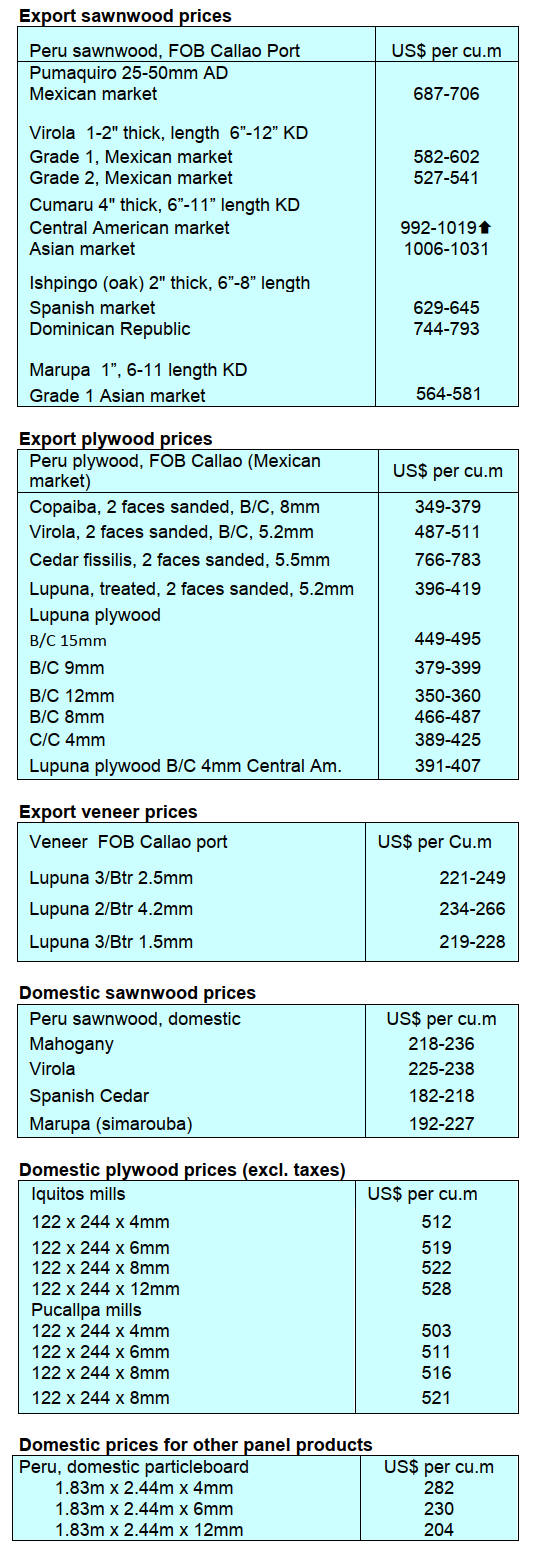
|